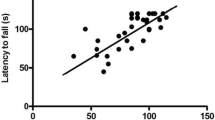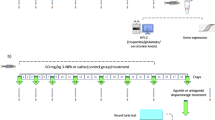Abstract
The mitochondrial toxin, 3-nitropropionic acid (3-NP), produces motor dysfunction and striatal atrophy in rats. However, rat strain and method of administration may contribute to variability in the deficits caused by 3-NP toxicity. To evaluate this, changes in nocturnal spontaneous locomotor activity from chronic administration of 3-NP using an osmotic mini pump, were examined in Lewis rats. Lewis rats were treated with 3-NP or saline for 2 days and behavior was tested daily for a 15 day period. Animals receiving 3-NP displayed significantly less spontaneous activity than animals in the saline group. 3-NP treated animals also weighed significantly less when compared to saline treated animals. These results demonstrate that even though there were no significant alterations in overt anatomical pathology, even short-term exposure to 3-NP produced significant effects. This short-term administration may present a potential paradigm for examination of sub-threshold neurotoxicity.
Similar content being viewed by others
References
Abercrombie M (1946) Estimation of nuclear population from microtome sections.Anat. Rec. 94, 239–247.
Alexi T, PD Hughes, RLM Faull and CH Williams (1998) 3-Nitropropionic acid’s lethal triplet: cooperative pathways of neurodegeneration.Neuroreport 9, R57-R64.
Blum D, MC Galas, D Gall, L Cuvelier and SN Schiffmann (2002) Striatal and cortical neurochemical changes induced by chronic metabolic compromise in the 3-nitropropionic model of Huntington’s disease.Neurobiol. Dis. 10, 410–426.
Borlongan CV, TK Koutouzis, TB Freeman, DW Cahill and PR Sanberg (1995a) Behavioral pathology induced by repeated systemic injections of 3-nitropropionic acid mimics the motoric symptoms of Huntington’s disease.Brain Res. 697, 254–257.
Borlongan CV, T Koutouzis, TS Randall, TB Freeman, DW Cahill and PR Sanberg (1995b) Systemic 3-nitropropionic acid: behavioral deficits and striatal damage in adult rats.Brain Res. Bull. 36, 549–556.
Borlongan CV, TK Koutouzis, TB Freeman, RA Hauser, DW Cahill and PR Sanberg (1997) Hyperactivity and hypoactivity in a rat model of Huntington’s disease: the system 3-nitropropionic acid model.Brain Res. Prot. 1, 253–257.
Brorson JR, PT Schumacker and H Zhang (1999) Nitric oxide acutely inhibits neuronal energy production. The Committees on Neurobiology and Cell Physiology.J. Neurosci. 19, 147–158.
Brouillet E, B Jenkins, B Hyman, R Ferrante, N Kowall, R Srivastava, D Roy, B Rosen and MF Beal (1993) Age dependent vulnerability of the striatum to the mitochondrial toxin 3-nitropropionic acid.J. Neurochem.60, 356–359.
Brouillet E, MC Guyot, V Mittoux, S Altairac, F Condé, S Palfi and P Hantraye (1998) Partial inhibition of brain succinate dehydrogenase by 3-nitropropionic acid is sufficient to initiate striatal degeneration in rat.J. Neurochem.70, 794–805.
Brouillet E, F Conde, MF Beal and P Hantraye (1999) Replicating Huntington’s disease phenotype in experimental animals.Prog. Neurobiol.59, 427–468.
Demougeot C, P Garnier, C Mossiat, N Bertrand, M Giroud, A Beley and C Marie (2001)N-Acetylaspartate, a marker of both cellular dysfunction and neuronal loss: its relevance to studies of acute brain injury.J. Neurochem.77, 408–415.
Duckworth EA, TK Koutouzis, CV Borlongan, MN Gordon, AE Willing, DW Cahill and PR Sanberg (1999) Rats receiving systemic 3-nitropropionic acid demonstrate impairment of memory in Morris water maze.Psychobiol.27, 561–566.
El Massioui N, S Ouary, F Cheruel, P Hantraye and E Brouillet (2001) Perseverative behavior underlying attentional set-shifting deficits in rats chronically treated with the neurotoxin 3-nitropropionic acid.Exp. Neurol. 172, 172–181.
Guyot MC, P Hantraye, R Dolan, S Palfi, M Maziére and E Brouillet (1997) Quantifiable bradykinesis, gait abnormalities and Huntington’s disease-like striatal lesions in rats chronically treated with 3-nitropropionic acid: a behavioral assessment.Neuroscience 79, 45–56.
Hagen TM, DL Yowe, JC Bartholomew, CM Wehr, KL Do, JY Park and BN Ames (1997) Mitochondrial decay in hepatocytes from old rats: membrane potential declines, heterogeneity and oxidants increase.Proc. Natl. Acad. Sci. USA 94, 3064–3069.
Hsieh CC and J Papaconstantinou (2002) The effect of aging on p38 signaling pathway activity in the mouse liver and in response to ROS generated by 3-nitropropionic acid.Mech. Ageing Dev. 123, 1423–1435.
Jenkins BG, E Brouillet, YC Chen, E Storey, JB Schulz, P Kirschner, MF Beal and BR Rosen (1996) Non-invasive neurochemical analysis of focal excitotoxic lesions in models of neu-rodegenerative illness using spectroscopic imaging.J. Cereb. Blood Flow Metab. 16, 450–461.
Koutouzis TK, CV Borlongan, TB Freeman, DW Cahill and PR Sanberg (1994) Intrastriatal 3-nitropropionic acid: a behavioral assessment.Neuroreport 5, 2241–2245.
Langley KC, C Bergson, P Greengard and CC Ouimet (1997) Co-localization of the D1 dopamine receptor in a subset of DARPP-32-containing neurons in rat caudate-putamen.Neuroscience 78, 977–983.
Ludolph AC, F He, PS Spencer, J Hammerstad and M Sabri (1991) 3-Nitropropionic acid-exogenous animal neurotoxin and possible human striatal toxin.Can. J. Neurol. Sci. 18, 492–498.
Maciel EN, AJ Kowaltowski, FD Schwalm, JM Rodrigues, DO Souza, AE Vercesi, M Wajner and RF Castilho (2004) Mitochondrial permeability transition in neuronal damage promoted by Ca2+ and respiratory chain complex II inhibition.J. Neurochem.90, 1025–1035.
Miquel J, AC Economos, J Fleming and JEJ Johnson (1980) Mitochondrial role in cell aging.Exp. Gerontology 15, 579–591.
Munujos P, J Coll-Cantí, F González-Sastre and FJ Gella (1993) Assay of succinate dehydrogenase activity by a colorimetric-continuous method using iodonitrotetrazolium chloride as electron acceptor.Anal. Biochem. 212, 506–509.
Ouary S, N Bizat, S Altairac, H Menetrat, V Mittoux, F Conde, P Hantraye and E Brouillet (2000) Major strain differences in response to chronic systemic administration of the mitochondrial toxin 3-nitropropionic acid in rats: implications for neuroprotection studies.Neuroscience 97, 521–530.
Przybyla-Zawislak BD, CS Kimb, SF Ali, W Slikker Jr and ZK Binienda (2005) The differential junB responses to inhibition of succinate dehydrogenase in rat hippocampus and liver.Neurosci. Lett. 381, 354–357.
Sanberg PR, K Wictorian and O Isacson (1994)Cell Transplantation for Huntington’s Disease (RG Landes Co.: Austin).
Sastre J, FV Pallardo, R Pla, A Pellin, G Juan, E O’Connor, JM Estrela, J Miquel and J Vina (1996) Aging of the liver: age associated mitochondrial damage in intact hepatocytes.Hepatology 24, 1199–1205.
Sharp AH, SJ Loev, G Schilling, SH Li, XJ Li, J Bao, MV Wagster, JA Kotzuk, JP Steiner, A Loet al. (1995) Widespread expression of Huntington’s disease gene (IT15) protein product.Neuron 14, 1065–1074.
Shear DA, J Dong, CD Gundy, KL Haik-Creguer and GL Dunbar (1998) Comparison of intrastriatal injections of quinolinic acid and 3-nitropropionic acid for use in animal models of Huntington’s disease.Prog. Neuro-Psychopharmacol. Biol. Psychiatr. 22, 1217–1240.
Shigenaga MK, TM Hagen and BN Ames (1994) Oxidative damage and mitochondrial decay in aging.Proc. Natl. Acad. Sci. USA 91, 10771–10778.
Stefanova N, Z Puschban, PO Fernagut, E Brouillet, F Tison, M Reindl, KA Jellinger, W Poewe and GK Wenning (2003) Neuropathological and behavioral changes induced by various treatment paradigms with MPTP and 3-nitropropionic acid in mice: towards a model of striatonigral degeneration (multiple system atrophy).Acta Neuropathologica 106, 157–166.
Teunissen CE, HW Steinbusch, M Angevaren, M Appels, C de Bruijn, J Prickaerts and J de Vente (2001) Behavioural correlates of striatal glial fibrillary acidic protein in the 3-nitropropionic acid rat model: disturbed walking pattern and spatial orientation.Neuroscience 105, 153–167.
Willing AE, P Nowicki, S Poulos, J Lixian, M Milliken, DW Cahill and PR Sanberg (2002) Effects of middle cerebral artery occlusion on spontaneous activity and cognitive function in rats.Int. J. Neurosci. 112, 503–516.
Author information
Authors and Affiliations
Corresponding author
Rights and permissions
About this article
Cite this article
Newcomb, J.D., Brown, W.D., Rodriguez, A.I. et al. Behavioral alterations in lewis rats following two-day continuous 3-nitropropionic acid administration. neurotox res 8, 259–265 (2005). https://doi.org/10.1007/BF03033979
Received:
Revised:
Issue Date:
DOI: https://doi.org/10.1007/BF03033979




